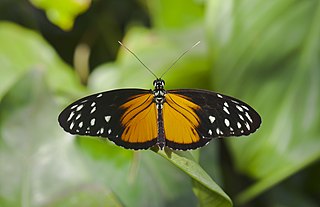
Heliconius hecale, the tiger longwing, Hecale longwing, golden longwing or golden heliconian, is a heliconiid butterfly that occurs from Mexico to the Peruvian Amazon. Hecale, was an old woman who gave shelter to Theseus on his way to capture the Marathonian Bull.
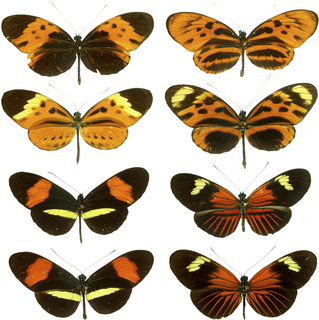
Heliconius comprises a colorful and widespread genus of brush-footed butterflies commonly known as the longwings or heliconians. This genus is distributed throughout the tropical and subtropical regions of the New World, from South America as far north as the southern United States. The larvae of these butterflies eat passion flower vines (Passifloraceae). Adults exhibit bright wing color patterns which signal their distastefulness to potential predators.

Heliconius ismenius, the Ismenius tiger or tiger heliconian, is a butterfly of the family Nymphalidae found in Central America and northern South America. They are abundant as far south as Ecuador and Venezuela and as far north as southern Mexico, Guatemala and Belize. H. ismenius are more commonly called the tiger-striped long wing butterfly. H. ismenius's nickname is derived from its long wing structure as well as the beautiful burnt orange and black stripes. Pierre André Latreille, a French zoologist, described Heliconius ismenius in 1817. H. ismenius resembles a number of other butterflies, an example of Müllerian mimicry.

Heliconius doris, the Doris longwing or Doris is a species of butterfly in the family Nymphalidae. It is known for being a polymorphic species which participates in various Müllerian mimicry rings throughout Central America and the Amazon rainforest. It is a species of special interest in biological science for the genetic basis and role of polymorphism (biology) in ecology and evolution.
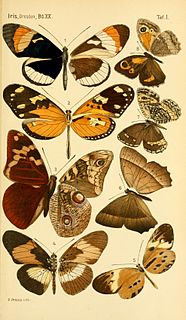
Gustav Weymer (1833–1914) was a German entomologist. He described many new taxa of butterflies from specimens collected by Alphons Stübel in South America.

Archonias is a monotypic genus of butterflies in the family Pieridae. Archonias brassolis, the cattleheart white, is its sole species. It is found from Central America, south through most of South America.

Telchin licus, the banana stem borer, is a moth of the Castniidae family. It is native to South America, where it is found from Colombia, Venezuela and the Guianas, throughout the Amazon basin in Brazil and Peru. It has also been recorded as an introduced species in Hawaii.

Melinaea menophilus, the Hewitson's tiger or Hewitson's tiger-wing, is a species of butterfly of the family Nymphalidae. It is found throughout the Amazonian region.

Lycorea halia, the tropical milkweed butterfly, is a species of nymphalid butterfly in the Danainae subfamily. It is found from Peru to the Caribbean and Mexico. Strays can be found as far north as Texas. The habitat consists of rainforest.

Heliconius numata, the Numata longwing, is a brush-footed butterfly species belonging to the family Nymphalidae, subfamily Heliconiinae.
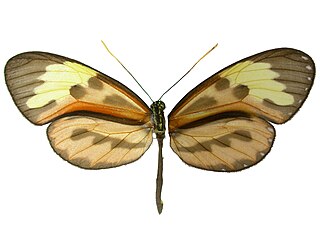
Ceratinia tutia, the tutia clearwing, is a species of butterfly of the family Nymphalidae. It is found from southern Mexico to Brazil. The wingspan is about 52 mm. It is a highly variable species. The larvae of subspecies Ceratinia tutia dorilla have been recorded feeding on Solanum species, including S. antillarum.

Heliconius antiochus, the Antiochus longwing, is a butterfly of the family Nymphalidae. It was described by Carl Linnaeus in 1767. It is found from Panama to the Amazon region. The habitat consists of riparian forests.
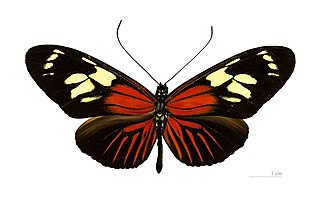
Heliconius burneyi, the Burney's longwing, is a butterfly of the family Nymphalidae. It was described by Jacob Hübner in 1831. It is found in the Amazon basin. The habitat consists of tall forests.

Heliconius demeter, the Demeter longwing, is a butterfly of the family Nymphalidae. It was described by Otto Staudinger in 1897. It is found in the Northern and Eastern part of the Amazon basin, from Guyana to Northern Brazil and Peru. The habitat consists of sandy rainforests.

Heliconius elevatus is a butterfly of the family Nymphalidae. It was described by Nöldner in 1901. It is found in the Amazon Basin. The habitat consists of riparian forests.

Heliconius ethilla, the ethilia longwing, is a butterfly of the family Nymphalidae. It was described by Jean-Baptiste Godart in 1819. It is found from Panama to southern Brazil. The habitat consists of marginal forests.

Heliconius ricini, the ricini longwing, is a butterfly of the family Nymphalidae. It was described by Carl Linnaeus in 1758. It is found from Venezuela and Trinidad to the Guianas and northern Brazil. The habitat consists of savanna-type areas.

Heliconius aoede, the Aoede longwing, is a species of butterfly of the family Nymphalidae. It was described by Jacob Hübner in 1813. It is found in the Amazon basin. The habitat consists of deep forests.

Heliconius telesiphe, the telesiphe longwing, is a butterfly of the family Nymphalidae. It was described by Edward Doubleday in 1847. It is found at mid-elevations in the Andes. Its habitat is cloud forests.

Heliconius eratosignis, the eratosignis longwing, is a butterfly of the family Nymphalidae. It was described by James John Joicey and George Talbot in 1925. It is found in the south-western Amazon basin, from Brazil to Peru and Bolivia. The habitat consists of sandy rainforests.









